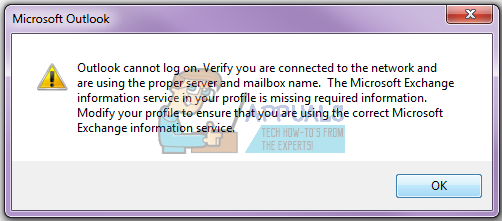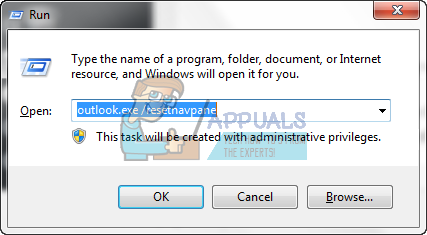Fix: Outlook cannot log on. Verify you are connected to the network and are using the proper server and mailbox name
Outlook cannot log on. Verify you are connected to the network and are using the proper server and mailbox name. The Mailbox Exchange information server in your profile is missing required information. Modify your profile to ensure that you are using the correct Microsoft Exchange information service. Happens because the root domain server is responding to the autodiscover request, and you will not be able to open Outlook, or use your account with it, for that matter. This happens due to the fact that Microsoft is constantly updating and upgrading its services, and oftentimes, in an attempt to make its users adhere to their new services, doesn’t update the configurations for its users.
A lot of users are getting this error, for both Outlook and Exchange, and the general conclusion is that Microsoft is to blame. This issue usually happens with Outlook 2016 but can happen with other versions as well. The message will lead you to believe that you need to update information in your profile, which is impossible to do since Outlook refuses to open and you can’t do anything with it.
However, there are a few things that you can do, such as modifying the registry or creating an .xml file that takes care of the issues with autodiscover. Read on to see what you can do about this issue.

Method 1: Use the /resetnavpane command
The resetnavpane switch clears and regenerates the Navigation Pane for the current user profile. It also removes all favorite folders and shortcuts, and does the same thing that deleting profilename.xml would do.
- Press the Windows key and R simultaneously on your keyboard, to open the Run dialog.
- In the dialog box, type the following command, and press Enter on your keyboard, or click
Outlook.exe /resetnavpane
Note that there is a space between “Outlook.exe” and “/resetnavpane”. This should help you fix the issue with Outlook and you can continue using it again.

Method 2: Delete the keys within the Profiles of Outlook, via the Registry Editor
Deleting a certain folder from the Registry Editor will cause Outlook to start repopulating the OST data. The OST data is used when you have an exchange account, and you want to use the Cached Exchange Mode or you simply want to work offline. Afterwards, you can continue using Outlook as usual. You can even attach a PST as well, which is used for IMAP, POP3 and web-based mail accounts, if you want or need.
- Press and hold the Windows and R keys on your keyboard.
- In the Run dialog, type regedit and press Enter, and click ok
- Now that you’re in the registry editor, use the left side navigation pane to go to the following folder:Note that 16.0 is for Office 2016 (Outlook 2016). If you’re using an older or newer version, the number will be a different number, as follows:
Outlook 2007 = \12\ Outlook 2010 = \14\ Outlook 2013 = \15\ Outlook 2016 = \16\
HKEY_CURRENT_USER\SOFTWARE\Microsoft\Office\16.0\Outlook\Profiles\Outlook
- Delete the keys in the folder.
Method 3: Tell Outlook not to respond to AutoDiscover, but your domain instead
The issue in question happens because the root domain server responds to the autodiscover request, and Outlook doesn’t even make it to AutoDiscover.[domain.com]. If you add the registry entry below, you are telling Outlook to ignore the root domain, and go to the next option on the list.
Option 1: Via Registry Editor
- Use steps 1 through 3 of the previous method, but stop after \16.0\Outlook, and don’t open the Profiles folder, but click the AutoDiscover one instead.
- Right-click on the right side, select New, and choose DWORD (32-bit) Value.
- Name the value ExcludeHttpsRootDomain
- After adding, double-click the value, and set the Value data to 1, leaving the Base as Hexadecimal
- Close the Registry Editor window, and Outlook should work as it’s supposed to again.
Option 2: Via an .xml file
- Create a text file which contains the text below, and save it as test.xml. You can create a text file by right-clicking anywhere on your desktop, going to New, and selecting Text Document.
<?xml version="1.0" encoding="utf-8"?> <Autodiscover xmlns="http://schemas.microsoft.com/exchange/autodiscover/responseschema/2006"> <Response xmlns="http://schemas.microsoft.com/exchange/autodiscover/outlook/responseschema/2006a"> <Account> <AccountType>email</AccountType> <Action>redirectUrl</Action> <RedirectUrl>https://YOUR_CAS_SERVER_NAME_HERE/autodiscover/autodiscover.xml</RedirectUrl> </Account> </Response> </Autodiscover>
- Save this file with a name and a location you know, and you know you won’t later on delete it by accident.
- Follow the first step of Option 1, to get to the AutoDiscover
- Create a new String value, and name it whatever your e-mail domain name is, for example com.
- Double-click the new value, and enter the path to the .xml file you just created.
- Create a DWORD value, name it PreferLocalXML
- Double-click it, and give it a value of 1.
- Close the Registry Editor, and try Outlook again.
Method 4: Delete your profile and create a new one
This is the last resort, as it completely deletes your Outlook profile, and you have to create a new one, and reconfigure your connection. Even though, the steps are listed below but if you would like a picture guide, then view
- Press the Windows button, and type Control Panel, then open the result, if using Windows 8 or newer. Older editions will have the Control Panel in the Start menu – open it directly from there.
- Switch to Icons view, large or small, and open
- Click Mail -> Profiles, and select the Outlook
- Click Remove to delete it.
- Click to add a new profile, name it Outlook1.
- Follow the instructions to configure your account again.
When you’re done, you will have created the account/profile again, only this time configured the way Windows likes it, and you won’t have any issues with it.
At the end of the day, this, along with a number of other issues, happens due to the fact that Microsoft constantly upgrades and evolves Windows, and not all new functionalities are compatible with their older counterparts. However, if you simply follow any of the methods above, you will have your Outlook account running again in no time.